How to care for hazelnuts and what you need to know about planting it
In the fluffy bushes of hazel, or hazel, high decorativeness and productivity are favorably combined. For a summer residence, it is better to choose its cultivated form - hazelnuts: it is unpretentious, and planting and caring for it will not cause difficulties even in the absence of significant experience in gardening. Its spreading bushes with bright foliage and powerful roots reach a height of 3 m, and their life expectancy reaches 80 years. Each of them can ripen up to 8-10 kg of nuts. But in order to achieve this, you need to follow the technology of growing crops.
Suitable plot
Hazelnut is a master of adaptation. It can adapt to any conditions, but this nut thrives best in sunny or poorly shaded areas. Lack of light is bad for the yield of the shrub. In the dense shade, the decorativeness of the hazelnuts also suffers: young branches dry up, and the color of the leaves loses its intensity. A place for growing a crop should be chosen warm and not blown by winds and drafts, without stagnating cold air in the spring.
The soil can be any, but the nut is most generous in the harvest in fertile, moist soil with a neutral reaction. The most unfavorable option for him is quickly drying earth and sand. Sour and podzolic soil will have to be limed before planting the shrub. It is better to do this in advance - a year before the procedure, but you can also before it. Having scattered lime over the site (at the rate of 0.5 kg of substance per 1 m²), dig up the soil, deepening by 1.5 bayonets of the shovel.
The terrain does not matter. Hazelnuts are found in lowlands, on steep and gentle slopes, on hills, near the shores of water bodies - everywhere they grow equally well. You can plant a nut on the site next to a shed or utility block, along a fence, at a gate or gate, at a wall of a house casting a shadow. Hazelnut hedges are spectacular and elegant.
Landing time and scheme
It is better to place shrubs on the site in the fall. After winter, the plant quickly wakes up, so they start planting in spring very early - already at the end of February - March, otherwise the hazelnuts will not take root. If the dacha is located in the middle lane or in the Urals, it is advisable to postpone the procedure until early October. Then the injured roots of the seedling will have time to heal before the cold weather, and with the arrival of heat, it will begin to grow actively.
There is a lot of room for the development of hazelnuts. Several layouts are used:
- 6x6 m;
- 5x6 m;
- 4x6 m;
- 4x5 m.
It is impractical to thicken the planting: the bushes will grow weak, and few nuts will ripen on them.
Advice
You can place hazelnuts in a nesting way. Having outlined a circle with a diameter of 1.5 m, 5-6 plants are planted along it, adhering to the 6x6 m scheme. In the future, they are formed into 1 trunk, getting rid of all root growth.
Prepare the soil 6 months before placing the seedlings in it. During this time, it should be steamed in order to accumulate as much moisture as possible. Its cleanliness is monitored by regularly pulling out weeds and loosening. It is advisable to cultivate deep layers of the soil, plunging into it by 50-60 cm. In oxygen-saturated loose soil, the roots of the bush will grow faster, it will take root easier. If the soil is not fertile enough, it is enriched with phosphorus-potassium compounds.
In order to achieve abundant fruiting of hazelnuts, several of its bushes (at least 2-3) are planted on the site, necessarily belonging to different varieties. Only in the presence of numerous neighbors will plants be able to fully pollinate. The dependence here is direct: the more varieties of crops are planted in the country, the more nuts are harvested from them.
Landing technique
The planting hole is dug at least 2 weeks before the plant is placed in it. Its optimal depth is 60 cm, and its width is 50 cm. Fertile soil is poured into the pit with a slide, adding fertilizers to it:
- humus (2-3 buckets) or manure (5-8 kg);
- superphosphate (150-200 g);
- potassium salt (50 g).
The supply of nutrients should be in the middle and upper part of the depression. With such a dressing, in the first 3-4 years of life in a new place, hazelnuts will not need feeding. A wooden stake is installed in the center of the pit. It will be a support for a young bush.
Hazelnut seedlings take root best of all at the age of 2 years. Having spread the roots of the plant, they are dipped in a mash made of clay or earth. The seedling is placed on a mound, but first they put under it (to a depth of about 15 cm) a couple of handfuls of soil with mycorrhiza taken from under a hazelnut. In order for the roots to branch and develop actively, the root collar of the bush should be 2-3 cm below the ground level. But you cannot sprinkle it with earth itself. Having well compacted the soil above the roots, they carry out abundant watering (3-5 buckets of water).
The surface of the hole is mulched. Any organic is suitable for this:
- sawdust;
- straw;
- needles;
- peat;
- humus;
- manure;
- compost.
The mulch will help retain soil moisture. But it must be moved away from the trunk in order to avoid bark heating. Planting ends with pruning of the plant - a stump with a height of 20-25 cm should remain from it, having 5-6 buds.
In order for the seedlings to take root faster, repeated watering is carried out after 5-7 days. This is especially important when planting hazelnuts in spring. In moist soil, its roots will quickly grow, and the hairs formed on them will help them more actively absorb water and nutrients necessary for the development of the aboveground part of the bush. To connect the soil capillaries, 2-3 waterings are required. When this happens, the planting ball will become inseparable from the rest of the soil. This will prevent it from drying out.
Watering and feeding
Further planting care involves standard procedures:
- watering;
- loosening the soil;
- top dressing;
- weed removal;
- pruning.
Hazelnuts love moisture and do not tolerate drought. Water it 5-6 times per season. Be sure to moisten the soil when the nut has bloomed, during the intensive growth of the ovaries and the laying of flower buds next year (in July) and after the foliage has flown. Watering should be abundant. It is carried out with warm water, spending 40-50 liters for each adult plant.
After moistening, the soil under the bushes is loosened. This should be done carefully, going deep into the soil by a maximum of 10-15 cm, so as not to damage the roots located almost at the surface. Experienced gardeners prefer not to take risks and instead of loosening, they cover the trunks with mown grass. Overheating, such mulch will become an additional source of nutrients for plants. This technique is also useful because the grass attracts worms, as a result of whose vital activity the fertility of the soil increases.
Growing hazelnuts will not be successful without regular feeding - they are needed throughout the growing season. In autumn, the soil in the trunks is enriched with wood ash. Such feeding accelerates fruiting and increases the yield of hazelnuts. In the spring and summer, plantings are fed by introducing the following components into the soil:
- manure or compost;
- humus;
- ammonium nitrate;
- phosphorus and potash fertilizers.
When the ovaries begin to form, the bushes are watered urea solution.
Moisten the soil before feeding. Having scattered nutritious compounds on it, they are embedded in the soil by shallow loosening. The trunk circle is watered and mulched again. The application of nitrogen fertilizers must be approached carefully: on poor soils, they will provoke an intensive growth of green mass, and little ovaries are formed on plants. An excess of nutrients will not benefit hazelnuts. Its bushes will grow actively, but the shoots will not have time to mature and will suffer from frost in winter.
Pruning and preparing for winter
Usually the hazelnut is shaped like a bush.Young shoots are most important - ovaries are formed on them. 7-10 are chosen from the lower branches - they form the skeleton of the bush. Excess branches are cut out. Shoots left behind should be strong, well developed and as far apart as possible. Be sure to get rid of diseased and damaged branches. The bush should not overgrow: this reduces its yield and creates a favorable environment for pathogens and pests. Therefore, caring for an adult plant consists in thinning it, removing dry branches and gradually rejuvenating the bush.
The formation of a hazelnut tree implies regular pruning all lateral shoots while maintaining the main trunk.
Advice
There is a little trick that will save you time and effort. A part of the plant trunk (5-6 cm above the soil with the obligatory capture of the root collar) is wrapped with a film, dropping its lower edge into the ground. Under it, root shoots will not be able to form.
Hazelnuts well tolerate the neighborhood of vegetable and melon crops, as well as strawberries. They can be planted between his young bushes so that the place on the site is not empty. When they grow, closing their crowns (after 5-6 years), it is better to sow the soil under them with perennial grasses. For tinning soil with a neutral reaction, cereals are suitable. If the earth is sour, it stands in the trunk circles plant lupine... Sowing a vetch-oat mixture will help improve the structure of the alkaline soil. The grown herbs will have to be mowed periodically.
In the fall, when the shrub leaves the leaves, they are raked up and burned. This is an excellent prevention of powdery mildew. It is advisable to dig up the soil in the near-trunk circles by 10-15 cm. Hazelnuts are frost-resistant culture, but it is better for it to winter with skeletal branches bent to the ground. So his male earrings will be protected from the cold. The shoots are pressed to the soil by the fallen snow. When it melts, the branches are raised.
There is nothing difficult in growing hazelnuts. Rare watering and feeding, in combination with proper pruning, will allow him to regularly delight the owners with healthy and nutritious nuts. And in lean years, disappointment from a small number of ovaries will smooth out the elegant look of the plant, which you can admire from early spring to late autumn.

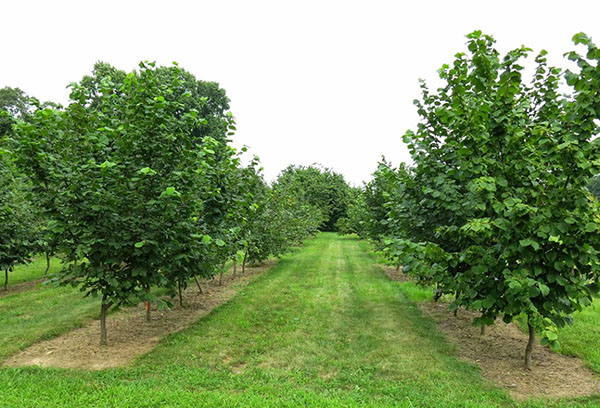

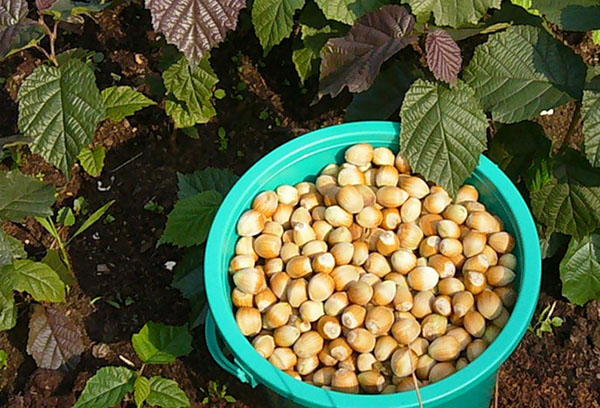


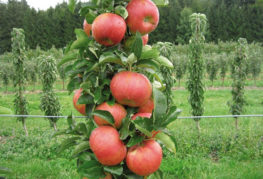
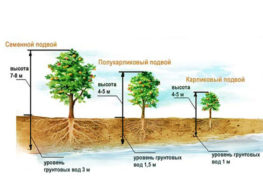
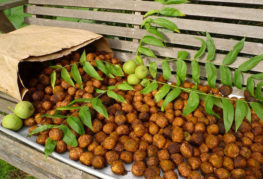
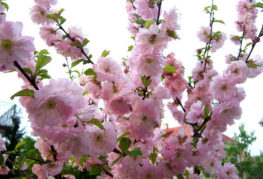
and will be published shortly.